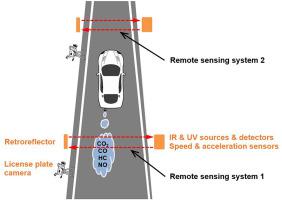Environmental Pollution ( IF 7.6 ) Pub Date : 2020-08-23 , DOI: 10.1016/j.envpol.2020.115456 Yuhan Huang , Yang Yu , Yat-shing Yam , John L. Zhou , Chengwang Lei , Bruce Organ , Yuan Zhuang , Wai-chuen Mok , Edward F.C. Chan

|
On-road remote sensing (RS) is a rapid, non-intrusive and economical tool to monitor and control the emissions of in-use vehicles, and currently is gaining popularity globally. However, a majority of studies used a single RS technique, which may bias the measurements since RS only captures a snapshot of vehicle emissions. This study aimed to use a unique dual RS technique to assess the characteristics of on-road vehicle emissions. The results show that instantaneous vehicle emissions are highly dynamic under real-world driving conditions. The two emission factors measured by the dual RS technique show little correlation, even under the same driving condition. This indicates that using the single RS technique may be insufficient to accurately represent the emission level of a vehicle based on one measurement. To increase the accuracy of identifying high-emitting vehicles, using the dual RS technique is essential. Despite little correlation, the dual RS technique measures the same average emission factors as the single RS technique does when a large number of measurements are available. Statistical analysis shows that both RS systems demonstrate the same Gamma distribution with ≥200 measurements, leading to converged mean emission factors for a given vehicle group. These findings point to the need for a minimum sample size of 200 RS measurements in order to generate reliable emission factors for on-road vehicles. In summary, this study suggests that using the single or dual RS technique will depend on the purpose of applications. Both techniques have the same accuracy in calculating average emission factors when sufficient measurements are available, while the dual RS technique is more accurate in identifying high-emitters based on one measurement only.
中文翻译:

使用双重遥感技术对道路车辆排放量进行统计评估
公路遥感(RS)是一种快速,无损且经济的工具,用于监视和控制在用车辆的排放,目前在全球范围内越来越受欢迎。但是,大多数研究使用的是单一RS技术,由于RS仅捕获车辆排放的快照,因此可能会使测量结果产生偏差。这项研究旨在使用独特的双重RS技术来评估公路车辆排放的特征。结果表明,在现实驾驶条件下,瞬时车辆排放具有很高的动态性。即使在相同的驾驶条件下,通过双RS技术测量的两个排放因子也显示出很小的相关性。这表明使用单个RS技术可能不足以基于一个测量准确地表示车辆的排放水平。为了提高识别高排放车辆的准确性,必须使用双重RS技术。尽管相关性很小,但是在有大量测量结果时,双RS技术测量的平均排放因子与单RS技术相同。统计分析表明两个RS系统都显示出相同的≥200次测量的伽马分布,导致给定车辆组的平均排放因子收敛。这些发现表明,需要至少200个RS测量的样本大小,以便为公路车辆生成可靠的排放因子。总之,这项研究表明使用单或双RS技术将取决于应用程序的目的。当有足够的测量可用时,两种技术在计算平均排放因子方面具有相同的精度,而双RS技术在仅基于一种测量来识别高发射极时更为准确。











































 京公网安备 11010802027423号
京公网安备 11010802027423号